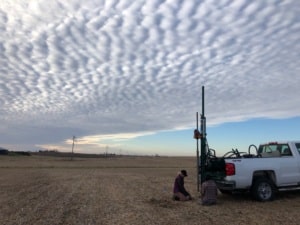Some people claim there is a growing disconnect between agricultural research and the farmers who are supposed to benefit from the findings of this research. I believe part of this disconnect comes from the fact that farmers are rarely involved in the studies intended to improve production practices or agricultural support programs. For example, much of what we know about the impacts of conservation practices like no-till and cover crops comes from agriculture experiments that are designed to hold certain factors constant (like fertilizer rate and seed variety) while varying a factor of interest (like tillage or cover crop species). While controlled experiments are great for understanding specific agronomic outcomes, they are not well suited for studying the impacts on farm economics, neighboring farmers, or the surrounding ecosystem.
How can our research programs be adapted to better meet the needs of farmers? Can research be used as a tool to strengthen ties between academics and producers?

In my Ph.D. research as a soil scientist at Colorado State University, I’ve found that interdisciplinary projects which evaluate problems at the systems-level have the potential to bridge the gap between researchers and agricultural communities. As I attempt to understand an agricultural challenge from multiple different angles, I have inevitably found myself embedded in the communities I hope to understand. For example, I have returned to several counties in Iowa several times in the past year: first to build relationships with local farmers, then to collect soil samples from their fields, and finally to conduct interviews with innovative farmers. Getting to know the farmers and their lives on a deeper level has forced me to question my assumptions about what is driving change in rural Iowa. I once believed that if farmers had access to the right financial incentives to plant cover crops or diversify their operations, they surely would. While that may be the case for some, I now understand that farming is more than just a strait business practice—there are numerous social and cultural pressures shaping farmer’s decisions. As an example: a farmer that adopts cover crops in a region where they are uncommon may receive criticism from their neighbors. Given the complex factors influencing farmer behavior and the diverse pressures within the greater food system, it is unlikely that one policy or program is the silver bullet to incentivize change.
A deeper, more accurate, understanding about the lives of farmers developed as I rode along in the combine or helped make repairs on an old tractor alongside farmers. As a result, I am investigating new research questions that never would have occurred to me previously by working alongside sociologists to explore factors affecting the adoption of conservation practices. Our preliminary research, which aligns with social science research of practice adoption, suggests that counties that have strong social ties and open communication within their communities have the highest rate of adoption of regenerative practices. For example, if a farmer who is transitioning to no-till farming can look across the road and see a friendly neighbor willing to offer mentorship, there is a greater likelihood that both of those farmers will stick with that practice.

If change starts on the ground amongst farmers and their trusted inner circles, how can our research promote this process? First, spending time in the agricultural communities where we are conducting research is essential. This requires putting down the scientific instruments and opening our ears, allowing for our assumptions to be challenged. Second, working closely with researchers in other disciplines, particularly the social sciences, can help us see issues in a new light. We accept that changing human behavior is a key to meeting sustainability goals, yet social scientists are often brought onto projects as an afterthought. We can more effectively address complex environmental challenges from a systems-level if we use social science methods to understand what is driving people to act in the ways they do. Third, we can initiate more collaborative, on-farm research directly with farmers. The most exciting agricultural innovations are developed by those whose livelihoods are dependent upon growing a successful crop and continuing to improve their land for future generations. As scientists, we can use data to prove the efficacy of the land stewardship already in use on farms and develop effective programs to get more farmers on board.
While I am early in my career and still have plenty to learn, I am so grateful for the opportunities I’ve had to work with incredible farmers across Iowa while expanding my interdisciplinary network. Without the support of the FFAR Fellows Program, this kind of research would not be possible for me. The FFAR Fellows program has armed me with a multitude of skills that have helped me work with diverse stakeholders, communicate my science to a range of audiences, and collaborate in interdisciplinary teams.
